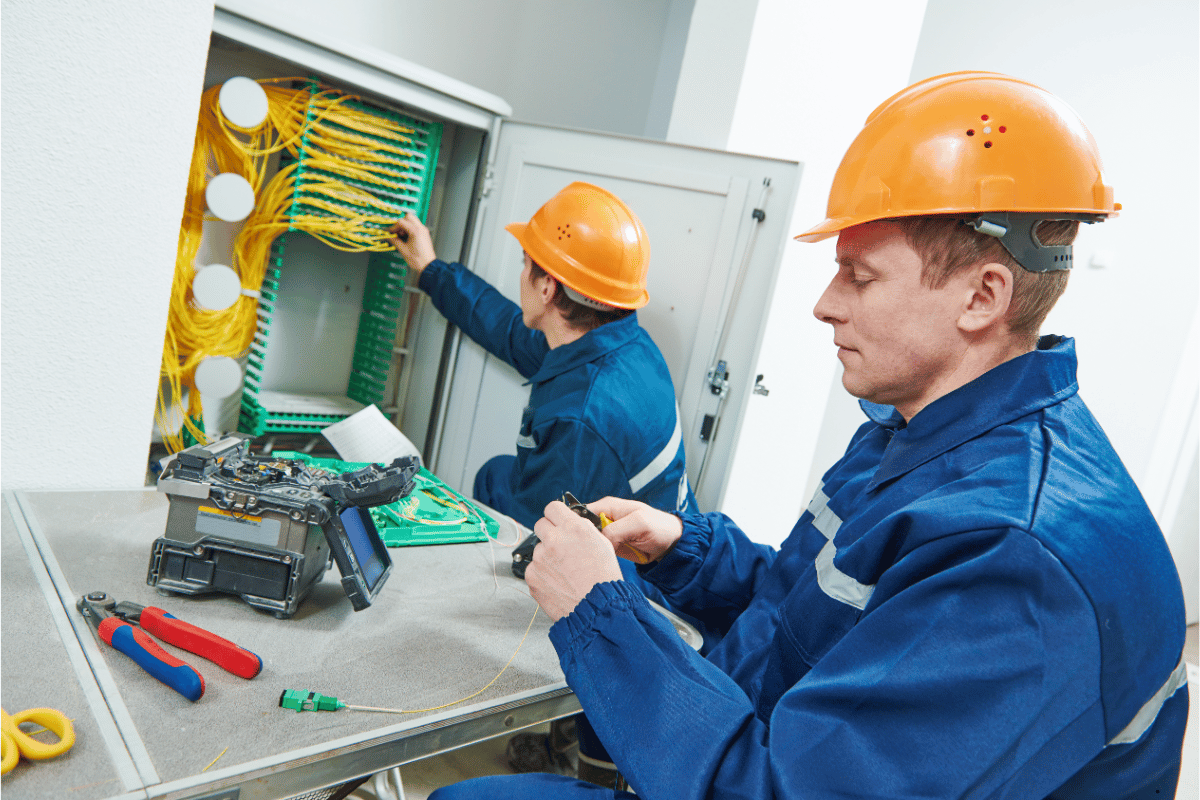Maximizing Connectivity: How Quality Cabling Enhances Data Networks
In the era of digital transformation, robust connectivity is the cornerstone of success for modern businesses. Whether it’s enabling real-time communication, facilitating cloud computing, or supporting mission-critical applications, the ability to transfer data quickly and reliably is a make-or-break factor for organizations of all sizes. At the heart of this endeavor lies a critical component: cabling. Often overlooked, these unassuming wires and fibers are the backbone that facilitates the flow of information within networks. From the smallest office to the largest data center, the quality of cabling directly impacts network performance, scalability, and security.
High-quality cabling isn’t merely a means of connecting devices; it’s an investment in the future of your business. By prioritizing robust cabling solutions, companies can ensure optimal data transfer, mitigate bottlenecks, and lay the foundation for future growth. Conversely, compromising on cabling quality can lead to frustrating lags, dropped connections, and vulnerabilities that undermine productivity and competitiveness. In this comprehensive guide, we’ll delve into the critical role of cabling in data network performance, exploring the core benefits of high-quality solutions. We’ll also examine the various cabling types and their applications, providing insights to help you make informed decisions tailored to your organization’s unique needs.
From structured copper cabling to fiber optic solutions, we’ll cover the advantages, performance metrics, and use cases of each option. In doing so, we aim to provide you with the necessary knowledge to make informed decisions when partnering with reputable network cabling companies. Whether you’re based in Doral, Florida, or elsewhere, selecting the right network cabling companies Doral fl can be crucial for ensuring a seamless and future-proof network infrastructure. By understanding the nuances of cabling types and their respective strengths, you’ll be better equipped to collaborate with these professionals and implement solutions tailored to your organization’s unique needs.

The Role of Cabling in Data Network Performance
Critical Pathways for Data Transfer
Cabling serves as the conduit through which data travels, enabling communication between devices, servers, and the Internet. Just as a robust highway system facilitates smooth traffic flow, high-quality cabling ensures that data packets move swiftly and accurately from one point to another within a network. This seamless transfer is crucial for applications that demand real-time data processing, such as video conferencing, streaming, and cloud computing.
Bottleneck Reduction
Data transfer bottlenecks can significantly impede network performance, leading to frustrating lags, dropped connections, and reduced productivity. Low-quality cabling is often the culprit behind these bottlenecks, as it introduces signal degradation, interference, and data loss. By investing in high-grade cabling solutions, businesses can mitigate these issues and maintain optimal data flow, ensuring that their networks operate at peak efficiency.
Core Benefits of High-Quality Cabling
Data Integrity and Signal Strength
Premium cabling is engineered to maintain signal strength over long distances, minimizing interference and ensuring data integrity. This is particularly crucial for large-scale networks spanning multiple buildings or campuses, where data must traverse substantial distances without compromising quality or speed.
Network Scalability and Future-Proofing
As businesses grow and technology advances, their network infrastructure must evolve to accommodate increasing data volumes and bandwidth requirements. Investing in high-quality cabling today not only meets current needs but also lays the groundwork for future scalability. With a robust cabling infrastructure in place, businesses can seamlessly integrate new technologies, expand their networks, and adapt to changing demands without the need for costly overhauls.
Enhanced Security
In an era where cyber threats are ever-present, secure cabling plays a vital role in safeguarding sensitive data. High-quality cabling solutions incorporate shielding and grounding mechanisms that protect against electromagnetic interference (EMI) and radio frequency interference (RFI), minimizing the risk of data breaches and ensuring the integrity of transmitted information.
Cabling Types and Their Applications
Copper Cabling: Structured Solutions
Copper cabling has been a staple in data networks for decades, offering cost-effective and reliable solutions for various applications. Within the realm of structured copper cabling, several standards exist, each with its unique advantages.
Cat5e, Cat6, Cat6a, Cat7
- Cat5e: This entry-level standard supports data transfer rates up to 1 Gigabit per second (Gbps) over a maximum distance of 100 meters, making it suitable for basic network applications.
- Cat6: With a bandwidth of up to 250 MHz, Cat6 cabling supports data rates up to 10 Gbps, making it an ideal choice for high-speed networks, multimedia applications, and Power over Ethernet (PoE) devices.
- Cat6a: Designed for even higher performance, Cat6a cabling offers a bandwidth of up to 500 MHz and supports data rates up to 10 Gbps over longer distances, making it well-suited for demanding applications such as high-definition video streaming and data centers.
- Cat7: The latest copper cabling standard, Cat7, supports data rates up to 100 Gbps over a distance of 15 meters, making it the optimal choice for high-density data centers and mission-critical applications that require ultra-high speeds.
Fiber Optic Cabling: High-Speed Connectivity
Fiber optic cabling has revolutionized data networks, offering unparalleled speed, bandwidth, and distance capabilities. These cables transmit data using light pulses, enabling faster and more efficient data transfer than traditional copper cabling.
Single-Mode vs. Multi-Mode
- Single-Mode Fiber: With a smaller core diameter, single-mode fiber is designed for long-distance data transmission, supporting data rates up to 100 Gbps over distances exceeding 10 kilometers. It’s ideal for backbone networks, metropolitan area networks (MANs), and wide area networks (WANs).
- Multi-Mode Fiber: Featuring a larger core diameter, multi-mode fiber is optimized for shorter distances, typically up to 600 meters. It supports data rates up to 10 Gbps and is commonly used in local area networks (LANs), data centers, and premises cabling.
Comparing Copper and Fiber Optics
When it comes to choosing between copper and fiber optic cabling, several factors come into play, including performance metrics, use cases, and cost considerations.
Performance Metrics Comparison
| Metric | Copper Cabling | Fiber Optic Cabling |
| Bandwidth | Up to 100 Gbps (Cat7) | Up to 100 Gbps (Single-Mode) |
| Latency | Higher latency due to electrical signal transmission | Lower latency due to light transmission |
| Distance | Up to 100 meters (Cat6) | Up to 10 kilometers (Single-Mode) |
| EMI/RFI Susceptibility | More susceptible to interference | Immune to electromagnetic interference |
| Installation Costs | Lower upfront costs | Higher upfront costs |
Optimizing Cable Management for Longevity and Performance
Physical Installation Best Practices
Proper cable installation is crucial for ensuring longevity and minimizing interference. Adhering to industry standards and best practices, such as using cable trays, maintaining bend radius guidelines, and implementing cable bundling techniques, can prevent cable damage and optimize performance.
Color Coding and Labeling Standards
Implementing standardized color coding and labeling practices for cabling infrastructure can greatly simplify network management and troubleshooting. By following established guidelines, such as the TIA-606-B standard, administrators can quickly identify cable types, destinations, and connections, streamlining maintenance and reducing downtime.
Routine Testing and Certification
Regular testing and certification of cabling infrastructure is essential for maintaining network integrity and identifying potential issues before they escalate. Employing specialized tools and following industry standards, such as the TIA-1152 Level III certifications, ensures that cabling systems meet performance requirements and comply with regulatory norms.
Network Monitoring and Continuous Improvement
Real-Time Monitoring
Proactive network monitoring is crucial for identifying and addressing potential vulnerabilities or performance bottlenecks before they impact operations. By leveraging advanced monitoring tools, administrators can gain real-time insights into network traffic patterns, bandwidth utilization, and cabling performance, enabling timely interventions and optimizations.
Data Analytics
In addition to real-time monitoring, leveraging data analytics can provide valuable insights into network behavior and trends. By analyzing historical data, businesses can anticipate future bandwidth needs, identify areas for cabling upgrades, and make informed decisions about infrastructure investments, ensuring their networks remain future-proof and aligned with evolving business requirements.

FAQs
1. How does cabling quality impact network latency?
Network latency, or the delay in data transmission, can be significantly influenced by cabling quality. Low-quality cables are more susceptible to signal degradation, resulting in increased latency and reduced network performance. High-quality cabling, on the other hand, minimizes signal attenuation and ensures that data packets reach their destination with minimal delays, enabling real-time applications and enhancing overall network responsiveness.
2. Is fiber optic cabling worth the investment for small to medium-sized businesses (SMBs)?
While fiber optic cabling typically involves higher upfront costs compared to copper cabling, it can offer substantial advantages for SMBs in certain scenarios. If your business deals with large data volumes, requires high bandwidth for applications like video conferencing or data backups or plans to expand its network infrastructure in the near future, investing in fiber optic cabling can provide a future-proof solution with superior speed, distance, and scalability capabilities.
3. What is the recommended cabling solution for hybrid network environments?
In hybrid network environments that incorporate both local area networks (LANs) and wide area networks (WANs), a combination of copper and fiber optic cabling is often the ideal solution. For horizontal cabling within a building or campus, structured copper cabling like Cat6a can provide cost-effective and high-performance connectivity. For the backbone network connecting multiple sites or buildings, fiber optic cabling (single-mode or multi-mode, depending on distance requirements) offers the necessary bandwidth and reach to enable seamless communication across the entire hybrid infrastructure.
By following industry best practices, investing in quality cabling solutions, and continuously monitoring and optimizing network performance, businesses can unlock the full potential of their data networks, enabling seamless connectivity, scalability, and long-term success in the digital era.
Conclusion
In the digital age, where data is the currency that drives businesses, investing in quality cabling is paramount for achieving network excellence. High-grade cabling solutions not only ensure seamless data transfer and optimal performance but also lay the foundation for scalability, security, and future-proofing.By selecting the appropriate cabling type – whether structured copper or fiber optic – and implementing best practices in cable management, businesses can maximize the longevity and efficiency of their network infrastructure. Routine testing, certification, and proactive monitoring further reinforce the reliability and resilience of these critical pathways.
While the upfront costs of high-quality cabling may seem daunting, the long-term benefits far outweigh the initial investment. Robust cabling solutions minimize downtime, enhance productivity, and enable businesses to stay ahead of the curve as technology evolves. By prioritizing quality cabling, companies can future-proof their networks, ensuring they remain competitive and agile in an ever-changing digital landscape.







